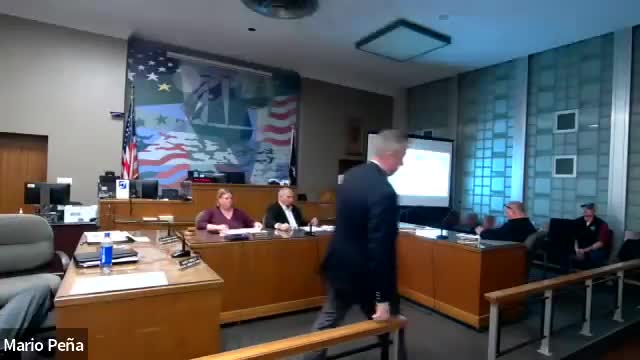DEC presents deer‑management options; residents press council for data and action
October 22, 2025 | Tonawanda, Erie County, New York
This article was created by AI summarizing key points discussed. AI makes mistakes, so for full details and context, please refer to the video of the full meeting. Please report any errors so we can fix them. Report an error »

A Region 9 biologist from the New York State Department of Environmental Conservation (DEC) gave an extended educational briefing to the Common Council on white‑tailed deer ecology and a menu of management tools that municipalities can use to address high deer densities and the damage they cause.
The DEC biologist summarized deer history in New York, population dynamics and the biology behind population growth. He said managers generally need to remove roughly 30–40% of a local deer population annually to hold numbers steady, because of deer reproduction and survivorship patterns. He described a range of options for municipalities and property owners, including deterrents and exclusion (planting choices, fencing, motion‑activated devices), education about feeding and tick prevention, and population‑reduction tools such as enhanced hunting seasons, deer‑management permits (DMPs) that allow sharpshooting or capture‑and‑euthanize operations, and fertility‑control methods. The presenter said immunocontraception is not currently registered for broad use in New York and that surgical sterilization has limited practical application in dense urban herds.
The DEC speaker emphasized that community buy‑in, clear objectives and an implementation plan are critical. He recommended that any municipality seeking to use deer‑management permits produce a simple deer‑management plan that sets objectives, monitoring, safety and reporting procedures.
During a lengthy public comment period after the presentation, multiple residents described heavy deer pressure in yards and parks, property damage to plantings and gardens, and collisions with vehicles. One resident said deer jumped a seven‑foot stockade fence and knocked it down; another said motion‑activated sprinklers and other deterrents had worked for some homeowners but not all. Several residents asked the council for aggregated data on deer‑vehicle collisions and documented complaints; the mayor and council suggested the police chief and city staff would be asked to compile collision and complaint records.
Residents asked whether relocation was an option; the DEC biologist said relocation is generally not feasible at scale and stressed the importance of local removal, monitored implementation and annual evaluation. The presenter also said public‑safety considerations and clear rules about who conducts sharpshooting (law enforcement, trained contractors or volunteers) are essential to any on‑the‑ground operation.
No formal council vote on a deer management program occurred at the meeting. Council members signaled interest in studying local collision and complaint data, convening public engagement, and then considering drafting a deer‑management plan should the data and public input warrant action.
The DEC biologist summarized deer history in New York, population dynamics and the biology behind population growth. He said managers generally need to remove roughly 30–40% of a local deer population annually to hold numbers steady, because of deer reproduction and survivorship patterns. He described a range of options for municipalities and property owners, including deterrents and exclusion (planting choices, fencing, motion‑activated devices), education about feeding and tick prevention, and population‑reduction tools such as enhanced hunting seasons, deer‑management permits (DMPs) that allow sharpshooting or capture‑and‑euthanize operations, and fertility‑control methods. The presenter said immunocontraception is not currently registered for broad use in New York and that surgical sterilization has limited practical application in dense urban herds.
The DEC speaker emphasized that community buy‑in, clear objectives and an implementation plan are critical. He recommended that any municipality seeking to use deer‑management permits produce a simple deer‑management plan that sets objectives, monitoring, safety and reporting procedures.
During a lengthy public comment period after the presentation, multiple residents described heavy deer pressure in yards and parks, property damage to plantings and gardens, and collisions with vehicles. One resident said deer jumped a seven‑foot stockade fence and knocked it down; another said motion‑activated sprinklers and other deterrents had worked for some homeowners but not all. Several residents asked the council for aggregated data on deer‑vehicle collisions and documented complaints; the mayor and council suggested the police chief and city staff would be asked to compile collision and complaint records.
Residents asked whether relocation was an option; the DEC biologist said relocation is generally not feasible at scale and stressed the importance of local removal, monitored implementation and annual evaluation. The presenter also said public‑safety considerations and clear rules about who conducts sharpshooting (law enforcement, trained contractors or volunteers) are essential to any on‑the‑ground operation.
No formal council vote on a deer management program occurred at the meeting. Council members signaled interest in studying local collision and complaint data, convening public engagement, and then considering drafting a deer‑management plan should the data and public input warrant action.
View full meeting
This article is based on a recent meeting—watch the full video and explore the complete transcript for deeper insights into the discussion.
View full meeting
